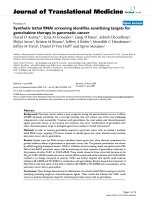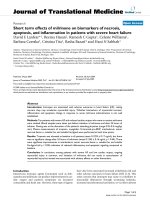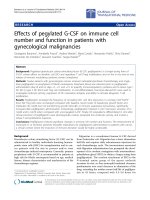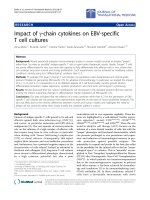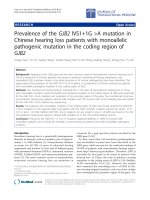Báo cáo hóa học: " Flexible IZO/Ag/IZO/Ag multilayer electrode grown on a polyethylene terephthalate substrate using roll-to-roll sputtering" doc
Bạn đang xem bản rút gọn của tài liệu. Xem và tải ngay bản đầy đủ của tài liệu tại đây (2.11 MB, 14 trang )
This Provisional PDF corresponds to the article as it appeared upon acceptance. Fully formatted
PDF and full text (HTML) versions will be made available soon.
Flexible IZO/Ag/IZO/Ag multilayer electrode grown on a polyethylene
terephthalate substrate using roll-to-roll sputtering
Nanoscale Research Letters 2012, 7:67 doi:10.1186/1556-276X-7-67
Han-Ki Kim ()
Jong-Wook Lim ()
ISSN 1556-276X
Article type Nano Express
Submission date 9 September 2011
Acceptance date 5 January 2012
Publication date 5 January 2012
Article URL />This peer-reviewed article was published immediately upon acceptance. It can be downloaded,
printed and distributed freely for any purposes (see copyright notice below).
Articles in Nanoscale Research Letters are listed in PubMed and archived at PubMed Central.
For information about publishing your research in Nanoscale Research Letters go to
/>For information about other SpringerOpen publications go to
Nanoscale Research Letters
© 2012 Kim and Lim ; licensee Springer.
This is an open access article distributed under the terms of the Creative Commons Attribution License ( />which permits unrestricted use, distribution, and reproduction in any medium, provided the original work is properly cited.
Flexible IZO/Ag/IZO/Ag multilayer electrode grown on a polyethylene
terephthalate substrate using roll-to-roll sputtering
Han-Ki Kim
*1
and Jong-Wook Lim
1
1
Department of Advanced Materials Engineering for Information and Electronics, Kyung
Hee University, 1 Seocheon-dong, Yongin-si, Gyeonggi-do, 446-701, South Korea
*Corresponding author:
Email addresses:
JWL:
HKK:
Abstract
We investigated the optical, electrical, structural, and surface properties of roll-to-roll
[R2R] sputter-grown flexible IZO/Ag/IZO/Ag [IAIA] multilayer films on polyethylene
terephthalate substrates as a function of the top indium zinc oxide [IZO] thickness. It was
found that the optical transmittance of the IAIA multilayer was significantly influenced
by the top IZO layer thickness, which was grown on identical AIA multilayers. However,
the sheet resistance of the IAIA multilayer was maintained between the range 5.01 to 5.1
Ω/square regardless of the top IZO thickness because the sheet resistance of the IAIA
multilayer was mainly dependent on the thickness of the Ag layers. Notably, the
optimized IAIA multilayer had a constant resistance change (∆R/R
0
) under repeated outer
bending tests with a radius of 10 mm. The mechanical integrity of the R2R-sputtered
IAIA multilayer indicated that hybridization of an IZO and Ag metal layer is a promising
flexible electrode scheme for the next-generation flexible optoelectronics.
Introduction
Flexible transparent conducting oxide [FTCO] electrodes with superior flexibility
have recently attracted much attention as key components in flexible displays,
photovoltaics, and touch panels because device performances are critically dependent on
optical, electrical, and mechanical properties of the FTCO [1-3]. In particular, the FTCO
electrode should have mechanical robustness against substrate bending without resultant
changes in its optical and electrical properties. Until now, amorphous indium tin oxide
[ITO] electrodes have been widely employed as an FTCO material in flexible
optoelectronic devices due to their high conductivity and transparency in the visible
spectral range [4]. However, easy formation and propagation of cracks in the brittle
amorphous ITO electrode have been considered as critical drawbacks of the amorphous
ITO electrode in flexible optoelectronics [5]. To solve these critical drawbacks of the ITO
electrode, flexible oxide-metal-oxide [OMO] multilayer electrodes, such as IZO/Ag/IZO,
ITO/Ag/ITO, IZTO/Ag/IZTO, GZO/Ag/GZO, AZO/Ag/AZO, NTO/Ag/NTO, and
ZTO/Ag/ZTO schemes, have been suggested due to their very low resistivity and high
Submitted to Materials Research Bulletin
2
transparency [6-11]. Another promising candidate for FTCO is an inverted multilayer
electrode, the metal-oxide-metal [MOM] multilayer structure. However, the existence of
opaque metal layers could reduce the optical transparency of the MOM multilayer even
though the MOM multilayer has a very low sheet resistance comparable to that of a metal
electrode. Therefore, an additional thin oxide layer on the MOM multilayer is required to
enhance the optical transparency of the MOM multilayer. However, the thickness effect
of the top oxide layer on the electrical and optical properties of the MOM multilayer has
not been investigated in detail.
In this work, we investigated the characteristics of flexible indium zinc oxide
[IZO]/Ag/IZO/Ag multilayer electrodes grown on polyethylene terephthalate [PET]
substrates using a specially designed roll-to-roll [R2R] sputtering system at room
temperature. The electrical, optical, and mechanical properties of the
IZO/Ag/IZO/Ag/PET samples were examined as a function of the top IZO thickness to
decide the optimum thickness of the top IZO layer. In addition, surface morphology of the
top IZO layer sputtered on the Ag/IZO/Ag multilayer was also investigated as a function
of the top IZO thickness. Furthermore, mechanical stability of the optimized
IZO/Ag/IZO/Ag multilayer under a repeated bending stress was examined using
lab-made bending test system.
Experimental detail
The IZO/Ag/IZO/Ag multilayer electrodes were deposited on PET substrates using a
specially designed lab-scale R2R sputtering system at room temperature. The R2R
sputtering system equipped a rewind roller, an unwind roller, a cooling drum, three
cathode guns, and a linear ion-beam source as shown Figure 1a. While 188-µm-thick PET
substrates were passed over the main cooling drum, each layer was consecutively
deposited on the PET substrate without substrate heating due to an excellent heat
transport to the cooling drum. To ensure a good heat transport from the PET substrate to
the cooling drum, an adjustable tension is applied to the rolling PET substrate by
controlling the unwind and rewind rollers. An Ag (99.999% purity) metal target and an
IZO (10 wt.% ZnO + 90 wt.% In
2
O
3
) ceramic target were placed at a distance of 100 mm
from the main drum. Due to a limited number of targets, the IZO/Ag/IZO/Ag multilayer
was prepared using two deposition steps. On the first step, the Ag (10 nm)/IZO (40
nm)/Ag (10 nm) multilayer was continuously deposited on the PET substrate at constant
DC powers of 800 W for the Ag target and 350 W for the IZO target, an Ar flow rate of 30
sccm, a working pressure of 3 mTorr, and a rolling speed of 0.5 m/min. To restrict
oxidation of the Ag metal target, reactive oxygen gas was not introduced into the chamber
during the R2R sputtering process. Then, on the second step, the top IZO layer was
deposited on the Ag/IZO/Ag multilayer as a function of thickness (0 to approximately 40
nm) at an identical sputtering condition with the bottom IZO layers. Thicknesses of the
top IZO layers on the Ag/IZO/Ag multilayer were effectively controlled by the DC power
of the IZO target. For simplicity, the IZO/Ag/IZO/Ag multilayer structure will be referred
to hereafter as ‘IAIA’. The thickness of each IZO and Ag layer was measured by a
thickness profilometer (Surfcorder ET-3000, Kosaka Laboratory Ltd., Chiyoda-ku,
Tokyo, Japan). A four-point probe (FPP-HS 8) and UV/Vis spectrometry (UV 540,
Unicam) measurements were employed to investigate the effect of top IZO thickness on
Submitted to Materials Research Bulletin
3
the electrical and optical properties of the IAIA electrode. Surface morphology of the top
IZO layer and structure of the IAIA multilayer were analyzed by a field effect scanning
electron microscope [FESEM] and X-ray diffraction [XRD] (D/MAX 2000, Rigaku
Corporation, Tokyo, Japan), respectively. The mechanical flexibility of the optimized
IAIA sample was analyzed using a lab-made bending test system [8]. The IAIA sample
with a size of 1.5 × 7 cm
2
was mechanically clamped tightly between two 45° tilted Cu
plates. To prevent increase of the resistance caused by the formation and propagation of
cracks in the clamped IAIA region, we employed tilted Cu plates. By repeated linear
motion of the Cu plates, we were able to flex and curve the IAIA sample and then
measured the resistance change ((R
1
−R
0
)/R
0
) of the flexed IAIA sample simultaneously.
The bending radius and frequency were approximately 10 mm and 60 Hz, respectively.
Results and discussion
Figure 2 shows the optical transmittance of the R2R-grown IAIA multilayer
electrodes on PET substrates as a function of the top IZO thickness. In the case of AIA (0
nm top IZO), it shows a low optical transmittance at specific wavelength regions of 300 to
400 nm and 600 to 700 nm due to the existence of metal Ag layers. The AIA multilayer
electrode shows only a high transparency at 500 to 550 nm wavelength region, unlike that
of the previously reported OMO multilayers [7-11]. This indicates that the antireflection
effect is not observed in the AIA multilayer even though a very thin Ag layer (10 nm) was
employed in the AIA structure. However, deposition of the top IZO layer on the AIA
multilayer leads to an increase in the optical transmittance of the AIAI multilayer,
especially in the wavelength above 500 nm. It was found that the optical transmittance of
the IAIA multilayer increased with increasing top IZO thickness of up to 30 nm. The
IAIA multilayer with 30-nm-thick top IZO layer showed the highest optical transmittance
of 82.56%. This indicates that the 30-nm thickness of the top IZO layer is desirable to
realize an antireflection effect in the AIAI multilayer structure. However, a further
increase of the top IZO electrode thickness (35 nm and 40 nm) resulted in a decrease of
transmittance. From these results, it is obvious that deposition of the top IZO layer on the
AIA multilayer is effective to improve the optical properties of the inverted AIA
multilayer electrode between 500 and approximately 700 nm wavelengths. However, to
apply the AIAI electrode in optoelectronic devices, further improvement of optical
transmittance in the blue wavelength region is necessary.
Figure 3 shows the sheet resistance, optical transmittance at a wavelength of 550 nm,
and figure of merit value (T
10
/R
sh
) calculated from the sheet resistance (R
sh
) and optical
transmittance (T) of the AIAI multilayer electrodes as a function of the top IZO thickness.
It was shown that the sheet resistance of the AIAI multilayer was fairly constant
(approximately 5 Ω/square) regardless of the top IZO thickness due the Ag metal layer
existence. The constant sheet resistance could be attributed to the existence of identical
Ag layers in all IAIA multilayers. In our previous work, we reported that the sheet
resistance and resistivity of the OMO multilayer were mainly determined by Ag thickness
and morphology because most of the current in the OMO multilayer flowed through the
inserted Ag metal layer [12]. However, the optical transmittance of the IAIA multilayer
electrode at a wavelength of 550 nm mainly depended on the top IZO thickness. As
expected from Figure 2, the IAIA multilayer with a 30-nm-thick top IZO layer showed
Submitted to Materials Research Bulletin
4
the highest optical transmittance and figure of merit value. Because the sheet resistance of
the IAIA multilayer electrode is constant regardless of the top IZO thickness, the figure of
merit value also follows the optical transmittance. The figure of merit value also increases
with the increasing top IZO thickness. A maximum figure of merit value of the IAIA
multilayer could be obtained at a top IZO thickness of 30 nm as indicated by a shadow
mark. It was thought that the IAIA multilayer showed a high optical transmittance and
figure of merit value at 30 nm in thickness of the top IZO layer because the antireflection
effect could occur at the symmetric oxide-metal-oxide [12]. However, a further increase
of top IZO thickness leads to a decrease of the figure of merit value due to the
diminishment of the antireflection effect in the IAIA multilayer.
Figure 4 shows the XRD plots obtained from the R2R sputter-grown IAIA multilayer
electrode as a function of the top IZO thickness. All XRD plots of the IAIA multilayer
electrodes show only the intense PET substrate peak at the region of 25.84° regardless of
the top IZO thickness. All XRD plots of the IAIA electrodes are identical. Due to a low
PET substrate temperature during the R2R sputtering process, all IAIA multilayers
exhibited a complete amorphous structure regardless of the top IZO thickness. However,
it is difficult to examine the microstructure of the thin Ag layer (10 nm) in detail due to
the limitation of our XRD power and resolution.
Figure 5 shows the surface FESEM images of the Ag layer in the AIA multilayer and
top IZO layer in the IAIA multilayer. In case of the 10-nm-thick Ag layer in Figure 5a, it
shows randomly the connected network structure (island plus layer). However, the
surface of the top IZO layer is fairly smooth and featureless without defect crack pinholes,
cracks, and protrusion. In the case of the top IZO layer with a thickness of 10 nm in Figure
5b, it showed a surface image similar to that of the Ag layer in Figure 5a because it was
directly sputtered on the randomly connected Ag islands. However, the surface of the top
IZO layer gets smooth with the increased thickness because the island-like Ag layer was
completely covered by the top IZO layer. At a top IZO thickness of 40 nm (Figure 5d), it
shows a very smooth surface morphology.
Figure 6a showed the pictures of the outer bending test using a lab-made bending test
system. Unlike conventional bending test systems, our system employed a tilted Cu
clamp in order to avoid the formation of cracks in the Cu-clamped region. Figure 6b
exhibited the change of measured resistance from the IAIA multilayer with inset of the
optical microscope images obtained from the top IZO layer before and after the bending
test. Changes in the resistance of the flexible IAIA multilayer electrode (IZO (30 nm)/Ag
(10 nm)/IZO (40 nm)/Ag (10 nm) sample) were expressed as (R
1
-R
0
)/R
0
, where R
0
is the
initial resistance and R
1
is the measured resistance value after substrate bending. The
optimized IAIA multilayer electrodes exhibited a constant resistance throughout the
2,000 bending cycles. The constant OM images before and after the bending test indicate
the robustness of the IAIA multilayer electrode. The superior flexibility of the IAIA
multilayer electrode could be attributed to the existence of an Ag metal layer between the
IZO layers. Lewis et al. reported that the presence of an Ag layer between the ITO layers
provides effective electrical conductivity even after the ITO is stressed beyond its failure
strain ( approximately 0.8%) due to the higher failure strain of the bulk-like Ag film (4%
to approximately 50%) [13].
Submitted to Materials Research Bulletin
5
Conclusions
In summary, we investigated the characteristics of IAIA multilayer electrodes grown
on PET substrates using a specially designed lab-scale R2R sputtering system at room
temperature. In two steps, we prepared the IAIA multilayer as a function of the top IZO
thickness. It was found that the optical transmittance of the IAIA multilayer was
significantly influenced by the thickness of the top IZO layer, which was grown on
identical AIA multilayers. However, the sheet resistance of the IAIA multilayer was
maintained between the range 5.01 to 5.10 Ω/square regardless of the top IZO thickness
because the sheet resistance of the IAIA multilayer was mainly dependent on thickness of
the Ag layers. In addition, all IAIA multilayers show an amorphous structure and a very
smooth surface due to the low substrate temperature which is maintained by the cooling
drum. Furthermore, the high failure strain of the inserted Ag layer improved the
robustness of the IAIA multilayer electrode. These results indicated that the R2R
sputter-grown IAIA multilayer electrode is a promising candidate to replace conventional
amorphous ITO electrodes.
Competing interests
The authors declare that they have no competing interests.
Authors' contributions
JWL carried out the R2R sputtering process and measured electrical and optical
properties of the IZO/Ag/IZO/Ag multilayer electrodes. HKK designed the experiments
and wrote the manuscript. All authors read and approved the final manuscript.
Acknowledgement
This work was mainly supported by the Samsung Mobile Display Research Center
Program.
References
1. Wong WS, Salleo A: Flexible Electronics. 1st edition. New York: Springer; 2009.
2. Crawford GP: Flexible Flat Panel Displays. 1st edition. England: John Wiley & Sons
Ltd.; 2005.
3. Pagliaro M, Palmisano G, Ciriminna R: Flexible Solar Cells. Weinheim: Wiley-VCH
Verlag, GmbH&Co; 2008.
4. Tahar RBH, Ban T, Ohya Y, Takahashi Y: Tin doped indium oxide thin films:
electrical properties. J Appl Phys 1998, 83:2631-2645.
5. Leterrier Y, Medico L, Demarco F, Manson JAE, Betz U, Escola MF, Olsson MK,
Submitted to Materials Research Bulletin
6
Atamny F: Mechanical integrity of transparent conductive oxide films for flexible
polymer-based displays. Thin Solid Films 2004, 460:156.
6. Park YS, Kim HK: Flexible indium zinc oxide/Ag/indium zinc oxide multilayer
electrode grown on polyethersulfone substrate by cost-efficient roll-to-roll
sputtering for flexible organic photovoltaics. J Vac Sci Technol 2010, A28:41-47.
7. Park YS, Choi KH, Kim HK: Room temperature flexible and transparent
ITO/Ag/ITO electrode grown on flexile PES substrate by continuous roll-to-roll
sputtering for flexible organic photovoltaics. J Phys D 2009, 42:235109.
8. Choi KH, Nam HJ, Jeong JA, Cho SW, Kim HK, Kang JW, Kim DG, Cho WJ: Highly
flexible and transparent InZnSnOx/Ag/InZnSnOx multilayer electrode for
flexible organic light emitting diodes. Appl Phys Lett 2008, 92:223302-223204.
9. Park YS, Kim HK, Kim SW: Thin Ag layer inserted GZO multilayer grown by
roll-to-roll sputtering for flexible and transparent conducting electrodes. J
Electrochem Soc 2010, 157:J301-J306.
10. Park JH, Choi YY, Kim HK, Lee HH, Na SI: The effects of rapid thermal annealing
on the electrical, optical, and structural properties of Nb:TiO2 multilayer
electrodes with an inserted nanoscale Ag layer for organic solar cells. J Appl Phys
2010, 108:083509-083517.
11. Choi YY, Choi KH, Lee H, Lee H, Kang JW, Kim HK: Nano-sized Ag-inserted
amorphous ZnSnO3 multilayer electrodes for cost-efficient inverted organic solar
cells. Sol Energy Mater Sol Cells 2011, 95:1615-1623.
12. Jeong JA, Kim HK: Low resistance and highly transparent ITO–Ag–ITO
multilayer electrode using surface plasmon resonance of Ag layer for bulk-hetero
junction organic solar cells. Sol Energy Mater Sol Cells 2009, 93:1801-1809.
13. Lewis J, Grego S, Chalamala B, Vick E, Temple D: Highly flexible transparent
electrodes for organic light-emitting diode-based displays. Appl Phys Lett 2004,
85:3450-3452.
Figure 1. R2R sputtering system schematic and IAIA sample structure. (a)
Schematic of a specially designed R2R sputtering system and (b) optimized structure of
an IZO/Ag/IZO/Ag multilayer on a PET substrate and picture showing visual
transparency of an IZO/Ag/IZO/Ag multilayer electrode.
Figure 2. Optical properties. Optical transmittance spectra of IZO/Ag/IZO/Ag
multilayer electrodes sputtered on PET substrates as a function of the top IZO thickness.
Submitted to Materials Research Bulletin
7
Figure 3. Electrical properties. Sheet resistance (R
sh
), optical transmittance at 550 nm,
and figure of merit value of the IZO/Ag/IZO/Ag multilayer as a function of the top IZO
layer.
Figure 4. Structural properties. XRD plots of the IZO/Ag/IZO/Ag multilayer
electrodes sputtered on PET substrates as a function of the top IZO thickness.
Figure 5. Surface FESEM images. Surface FESEM images of (a) reference Ag/IZO/Ag
and (b) IZO (10 nm)/Ag/IZO/Ag, (c) IZO (20 nm)/Ag/IZO/Ag, (d) IZO (40
nm)/Ag/IZO/Ag multilayer electrodes.
Figure 6. Bending test and in-situ measured resistance. (a) The pictures of the bending
test steps and (b) variation of the in-situ measured resistance ((R
1
-R
0
)/R
0
) during repeated
bending cycles for R2R-sputtered IZO/Ag/IZO/Ag multilayer electrodes, with inset
optical microscope images of the top IZO layer before and after the bending test.
Figure 1
300 400 500 600 700
0
20
40
60
80
100
Top IZO(40nm)
Top IZO(35nm)
Top IZO(30nm)
Top IZO(25nm)
Top IZO(20nm)
Top IZO(15nm)
Top IZO(10nm)
Top IZO(5nm)
Reference
Transmittance [%]
Wavelength [nm]
Figure 2
0 10 20 30 40
3
4
5
6
7
8
Sheet resistance
Transmittance at 550 nm
Figure of merit
Top IZO thickness [nm]
Sheet resistance [ohm/sq]
63
70
77
Transmittance at 550 nm [%]
Optimized condition
0
8
16
24
Figure of merit [10
-3
ohm
-1
]
Figure 3
20 30 40 50 60 70 80
Top IZO ( 5nm)
Top IZO (40nm)
Top IZO (35nm)
Top IZO (30nm)
Top IZO (25nm)
Top IZO (20nm)
Top IZO (15nm)
Top IZO (10nm)
Reference
Inyensity [a.u.]
2theta [deg.]
25.9
o
PET substrates
Figure 4
Figure 5
0 500 1000 1500 2000
0
1
2
3
4
R
1
-R
0
)/R
0
Bending cycle
Before
After
b
a
Figure 6

